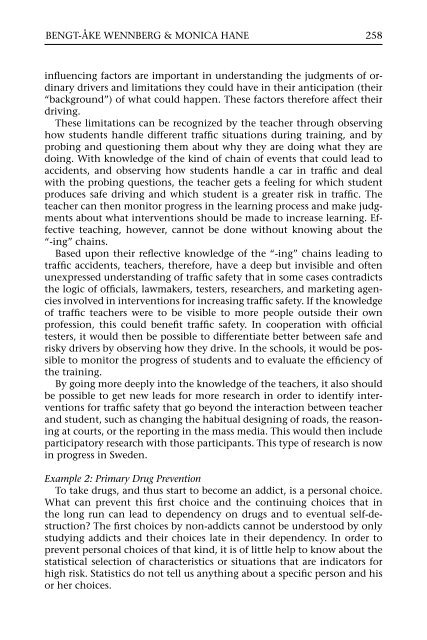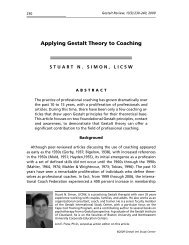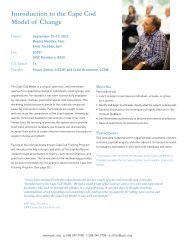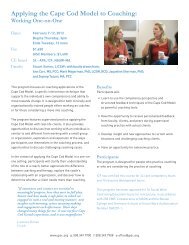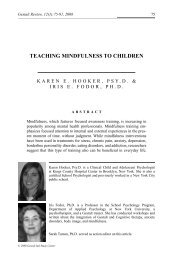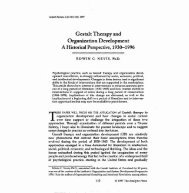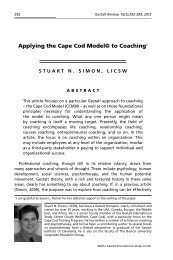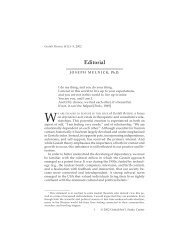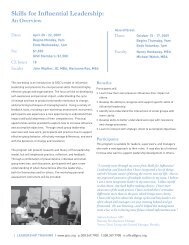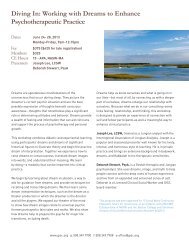Kurt Lewin's Heritage: A Possible Breakthrough? - Gestalt ...
Kurt Lewin's Heritage: A Possible Breakthrough? - Gestalt ...
Kurt Lewin's Heritage: A Possible Breakthrough? - Gestalt ...
You also want an ePaper? Increase the reach of your titles
YUMPU automatically turns print PDFs into web optimized ePapers that Google loves.
BENGT-ÅKE WENNBERG & MONICA HANE<br />
258<br />
influencing factors are important in understanding the judgments of ordinary<br />
drivers and limitations they could have in their anticipation (their<br />
“background”) of what could happen. These factors therefore affect their<br />
driving.<br />
These limitations can be recognized by the teacher through observing<br />
how students handle different traffic situations during training, and by<br />
probing and questioning them about why they are doing what they are<br />
doing. With knowledge of the kind of chain of events that could lead to<br />
accidents, and observing how students handle a car in traffic and deal<br />
with the probing questions, the teacher gets a feeling for which student<br />
produces safe driving and which student is a greater risk in traffic. The<br />
teacher can then monitor progress in the learning process and make judgments<br />
about what interventions should be made to increase learning. Effective<br />
teaching, however, cannot be done without knowing about the<br />
“-ing” chains.<br />
Based upon their reflective knowledge of the “-ing” chains leading to<br />
traffic accidents, teachers, therefore, have a deep but invisible and often<br />
unexpressed understanding of traffic safety that in some cases contradicts<br />
the logic of officials, lawmakers, testers, researchers, and marketing agencies<br />
involved in interventions for increasing traffic safety. If the knowledge<br />
of traffic teachers were to be visible to more people outside their own<br />
profession, this could benefit traffic safety. In cooperation with official<br />
testers, it would then be possible to differentiate better between safe and<br />
risky drivers by observing how they drive. In the schools, it would be possible<br />
to monitor the progress of students and to evaluate the efficiency of<br />
the training.<br />
By going more deeply into the knowledge of the teachers, it also should<br />
be possible to get new leads for more research in order to identify interventions<br />
for traffic safety that go beyond the interaction between teacher<br />
and student, such as changing the habitual designing of roads, the reasoning<br />
at courts, or the reporting in the mass media. This would then include<br />
participatory research with those participants. This type of research is now<br />
in progress in Sweden.<br />
Example 2: Primary Drug Prevention<br />
To take drugs, and thus start to become an addict, is a personal choice.<br />
What can prevent this first choice and the continuing choices that in<br />
the long run can lead to dependency on drugs and to eventual self-destruction?<br />
The first choices by non-addicts cannot be understood by only<br />
studying addicts and their choices late in their dependency. In order to<br />
prevent personal choices of that kind, it is of little help to know about the<br />
statistical selection of characteristics or situations that are indicators for<br />
high risk. Statistics do not tell us anything about a specific person and his<br />
or her choices.


